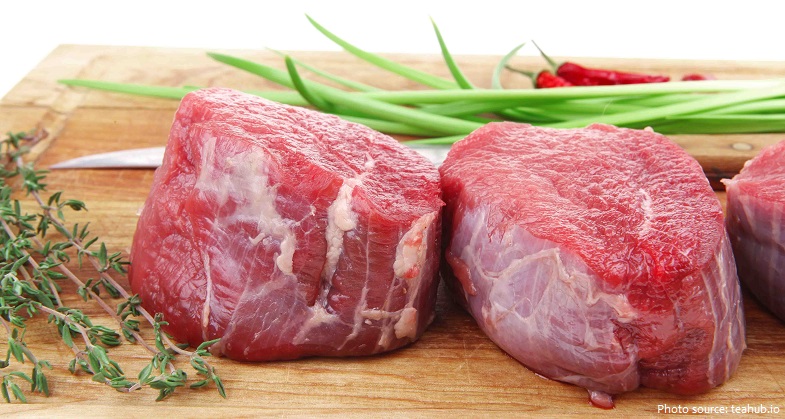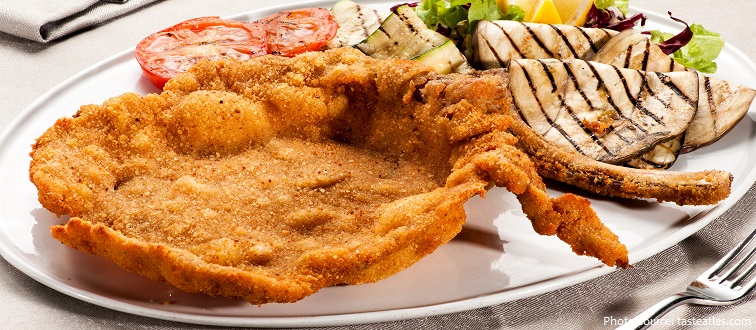
Veal is the meat of calves, in contrast to the beef from older cattle.
It has been treasured for centuries for its delicious, succulent flavor.
Eating the meat from young calves is referenced in the Bible several times where the “fatted calf” was regarded as the choicest of animal food.
Romans enjoyed veal and soon consumption of veal spread throughout early European culture.
Most veal comes from young male calves of dairy breeds which are not used for breeding.

Veal is delicate in flavour, pale grayish white in colour, firm and fine-grained, with velvety texture. It has no marbling, and the small amount of fat covering is firm and white.
In modern livestock farming, calves bred to yield high-quality veal are raised indoors under controlled temperatures and intensively fed on milk, high-protein calf meal, or both. Herbaceous foods are excluded, resulting in an iron deficiency producing the desirable light colour in the meat.
In Italian, French and other Mediterranean cuisines, veal is often in the form of cutlets, such as the Italian cotoletta or the famous Austrian dish Wiener Schnitzel. Some classic French veal dishes include fried escalopes, fried veal Grenadines (small, thick fillet steaks), stuffed paupiettes, roast joints, and blanquettes.

Because veal is lower in fat than many meats, care must be taken in preparation to ensure that it does not become tough. Veal is often coated in preparation for frying or eaten with a sauce. Veal parmigiana is a common Italian-American dish made with breaded veal cutlets.
In addition to providing meat, the bones of calves are used to make a stock that forms the base for sauces and soups such as demi-glace. Calf stomachs are also used to produce rennet, which is used in the production of cheese. Calf offal is also widely regarded as the most prized animal offal.
Wiener Schnitzel is a type of schnitzel made of a thin, breaded, pan-fried veal cutlet. In Austria the term is protected by law – “Wiener Schnitzel” assures you of a veal cutlet. Since veal is pricey, a less expensive Austrian alternative uses pork (Wiener Schnitzel vom Schwein). It can also be made with beef, chicken, mutton, pork, turkey, boar and reindeer—any meat that can be cut into thin slices. Just call it Chicken Schnitzel instead of Wiener Schnitzel.

Veal Milanese is an Italian dish in Milanese Lombard cuisine, and a popular variety of cotoletta. It is traditionally prepared with a veal rib chop or sirloin bone-in and made into a breaded cutlet, fried in butter. Due to its shape, it is often called oreggia d’elefant in milanese or orecchia d’elefante in Italian, meaning elephant’s ear.
Karađorđe’s schnitzel is a Serbian breaded cutlet dish named after a Serbian revolutionary Karađorđe. It is a rolled veal or pork steak, stuffed with kajmak, and then breaded and fried. It is served with roasted potatoes and tartar sauce.
Veal Orloff is a 19th-century dish of Russian cuisine, which purportedly was created by the French chef Urbain Dubois in the employ of Prince Orloff, former Russian ambassador to France. The dish consists of a braised loin of veal, thinly sliced, filled with a thin layer of finely chopped mushrooms (duxelles) and onions (as soubise) between the slices, then reassembled in the original shape. It is then topped with Mornay sauce (bechamel sauce with cheese) and browned in the oven.

Wallenbergare is a Swedish dish generally consisting of ground veal, cream, egg yolks and coated in breadcrumbs. It is traditionally served with boiled or mashed potatoes, lingonberry jam and green peas.
Hortobágyi palacsinta is a savoury Hungarian crepe, filled with veal. The meat is prepared as a stew – the meat is fried with onions and spices like the pörkölt or the paprikás dish, using veal, veal with mushrooms, chicken, or Hungarian sausage. The crêpes are filled with the stew, tucking in the ends, and are baked in the oven with a paprika and tejföl (sour cream) sauce, then topped with fresh parsley.
Cotoletta is an Italian word for a veal breaded cutlet. There are several Italian variations, as well as in other countries due to Italian diaspora.

A Weisswurst is a traditional Bavarian sausage made from minced veal and pork back bacon. It is usually flavored with parsley, lemon, mace, onions, ginger and cardamom, although there are some variations. Then the mixture is stuffed into pork casings and separated into individual sausages measuring about ten to twelve centimeters in length and three to four centimeters in thickness.
Veal liver sausage is seen as a delicacy in Austria as veal liver itself is quite expensive.
It is often served rare in European countries but is usually thoroughly cooked in the US.
Veal contains vitamins, amino acids and other useful nutrients. Even heat treatment does not affect the chemical composition of meat and the human body receives substances in their primary form.
Generally, veal is more expensive per pound than beef from older cattle. Veal production is a way to add value to dairy bull calves and to utilize whey solids, a byproduct from the manufacturing of cheese.